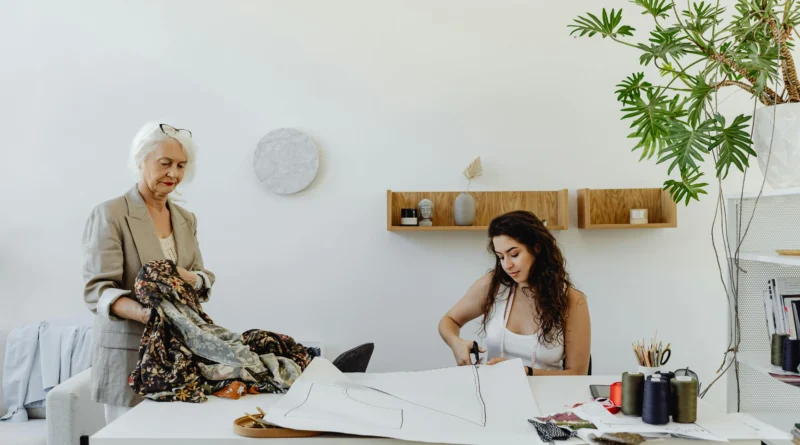10 Affordable Sewing Room Makeover Ideas for a Fresh New Look
Table of Contents
Introduction to Affordable Sewing Room Makeovers
Creating an inspiring and functional sewing room doesn’t have to break the bank. With a bit of creativity and strategic planning, even a modest budget can lead to significant improvements. The key is to focus on organization, lighting, and storage solutions. Affordable accents and smart space utilization can also dramatically enhance the room’s aesthetic appeal. By incorporating DIY projects and repurposing items, one can keep costs low while achieving a personalized space. Emphasizing practicality without sacrificing style is essential in making a sewing room both efficient and inviting.
Declutter and Organize Your Sewing Space
A tidy sewing space enhances creativity and efficiency. Begin by sorting through fabrics, patterns, and tools. Dispose of items no longer needed.
- Categorize Supplies: Separate by type – fabric, thread, notions, tools.
- Utilize Storage Solutions:
- Clear bins for visibility
- Label each container
- Invest in Furniture:
- Shelving units for vertical storage
- Drawer organizers for small items
- Designate Zones:
- Cutting area
- Sewing machine station
- Fabric storage
Clear workspace facilitates smoother projects and a more enjoyable sewing experience.
Revitalize with a Fresh Coat of Paint
Revamping the sewing room’s color scheme can significantly enhance the ambiance. Professional decorators recommend choosing light, neutral shades to make smaller spaces feel larger. Alternatively, for added vibrancy, select bold accent walls.
Consider the following tips:
- Select washable paints: Facilitates easy cleaning of inevitable fabric and thread marks.
- Opt for eco-friendly paints: Minimizes harmful fumes.
- Color-coordinate with furniture: Creates a cohesive look.
- Use painter’s tape: Achieves clean, sharp lines.
Investing in high-quality paint ensures durability, preventing frequent touch-ups. Prioritize a matte or satin finish to minimize glare, providing a comfortable and professional environment for creative projects.
Invest in Functional Storage Solutions
Investing in functional storage solutions can significantly enhance the organization and efficiency of a sewing room. Utilizing multi-purpose storage units helps maximize the available space. Consider implementing:
- Shelving Units: Adjustable shelves accommodate different sizes of fabric and tools.
- Pegboards: Ideal for hanging small tools, scissors, and spools of thread.
- Labeled Containers: Transparent boxes or jars keep materials visible and organized.
- Rolling Carts: Portable carts provide flexible storage options for frequently used items.
- Drawer Organizers: Segmented drawers prevent clutter and keep small items sorted.
Prioritize modular and stackable solutions to adapt easily to changing storage needs.
Upgrade Your Sewing Furniture
Crafting an efficient and attractive sewing space begins with quality furniture. Investing in specialized sewing furniture can enhance productivity and comfort. Start by considering the following updates:
- Ergonomic Chairs: Opt for adjustable chairs with lumbar support to maintain posture during long sewing sessions.
- Sewing Tables: Look for sturdy tables with adjustable heights and built-in storage for sewing supplies.
- Cutting Tables: A waist-high cutting table can reduce strain when cutting fabrics.
- Storage Solutions: Implement modular storage units to organize fabrics, threads, and tools neatly.
- Lighting: Add task lighting to minimize eye strain and ensure precision.
Upgrading sewing furniture is crucial for a tailored, efficient workspace.
Incorporate Multi-purpose Workstations
Opting for multi-purpose workstations can optimize both space and functionality in a sewing room. These versatile setups can accommodate various activities, from cutting fabric to ironing seams. Consider the following elements to enhance the efficiency of a sewing space:
- Convertible Tables: Utilize tables with adjustable heights or foldable designs.
- Built-in Storage: Incorporate cabinets and drawers for easy access to tools and materials.
- Adaptable Surfaces: Employ surfaces that can double as cutting tables and ironing boards.
- Ergonomic Designs: Ensure chairs and workspaces support comfortable, healthy postures.
A well-organized station maximizes productivity and keeps the sewing area tidy.
Use Mirrors to Amplify Natural Light
Incorporating mirrors into a sewing room can effectively increase the amount of natural light in the space.
- Position Mirrors Strategically: Place mirrors opposite windows to reflect light throughout the room.
- Use Large Mirrors: Opt for full-length or large wall mirrors to cover more surface area and spread light effectively.
- Decorative Mirrors: Choose mirrors with decorative frames to add a stylish touch while serving a functional purpose.
- Angle Mirrors: If possible, angle mirrors to direct light into darker corners.
- Mirror Groupings: Arrange small mirrors in a cluster to create a focal point and enhance the light diffusion.
Personalize with DIY Decor Projects
Infuse personality into the sewing room by incorporating DIY decor projects. These creative touches not only add visual appeal but also serve practical purposes.
- Fabric-Covered Pin Cushions
- Easy to make with scrap fabric.
- Provides a customized touch.
- Handmade Fabric Bins
- Ideal for storing fabrics and tools.
- Made with coordinating fabrics for a cohesive look.
- Decorative Thread Racks
- Organizes threads while adding aesthetic value.
- Can be painted to match the room’s color scheme.
- Embroidered Wall Art
- Showcases unique designs and techniques.
- Adds a personal touch to the room’s decor.
Add Greenery to Your Sewing Room
Integrating plants into the sewing room can bring vibrancy and improve air quality. Consider these plant options:
- Succulents: Easy to maintain and perfect for smaller spaces.
- Spider Plants: Known for their air-purifying qualities.
- Fiddle Leaf Fig: Ideal for corners with adequate light.
When positioning plants, ensure they receive appropriate sunlight. Hanging planters can save surface space and add visual interest. Self-watering planters are a practical choice for those with busy schedules. Adding greenery can create a calming atmosphere, fostering creativity and reducing stress. Prioritize low-maintenance varieties to keep the focus on sewing.
Enhance Lighting for Better Visibility
Good lighting is crucial for any sewing room to reduce eye strain and ensure accurate stitching. Natural light should be maximized by positioning the sewing table near windows. If natural light is insufficient, consider the following lighting options:
- Task Lights: Use adjustable task lights with LED bulbs for focused illumination on the sewing area.
- Overhead Lighting: Install bright overhead lights, preferably fluorescent or LED, to evenly light up the room.
- Under-cabinet Lights: Place strip lights under shelves or cabinets to illuminate work surfaces.
Proper lighting enhances precision, making sewing projects more enjoyable and efficient.
Opt for Budget-Friendly Flooring Options
Choosing cost-effective flooring can significantly transform a sewing room without overspending. Vinyl flooring offers durability and ease of installation, making it a practical choice. Laminate flooring imitates wood and can resist wear and tear, ideal for a busy workspace. Carpet tiles, customizable and easy to replace, provide comfort underfoot. Linoleum, made from natural materials, is another economical and eco-friendly option.
Consider these benefits:
- Vinyl: Water-resistant, easy to clean.
- Laminate: Scratch-resistant, aesthetic appeal.
- Carpet tiles: Noise reduction, cushioning.
- Linoleum: Sustainable, long-lasting.
Affordable flooring doesn’t compromise on style or functionality.
Conclusion and Final Touches
Implementing these 10 affordable ideas can breathe new life into any sewing room. Attention to detail is crucial in the process. One should:
- Reevaluate the Layout: Make optimal use of available space.
- Incorporate Personal Touches: Display pattern collections or handmade items.
- Add Practical Storage Solutions: Utilize labeled bins and clear containers.
- Invest in Proper Lighting: Ensure both task and ambient lighting are adequate.
- Use Inspiration Boards: Keep creative ideas and fabric swatches in view.
- Maintain Cleanliness: Regular organizing sessions prevent clutter buildup.
Considering these elements will enhance functionality and aesthetic appeal.

